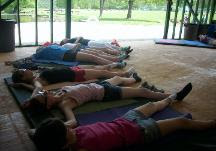
Yoga can Improve Brain Functioning for Children
with Autism & Sensory Processing Disorders
Autism is a brain disorder that begins in early childhood and persists throughout adulthood; it affects three crucial areas of development: communication, social interaction, and creative or imaginative play. Autism or ASD & SPD, impacts the ability to focus, control impulses, complete activities, remain calm in stressful situations (physically, mentally, and/or emotionally), transition from one activity to another, engage in social interactions, and respond appropriately to the environment.
Based on the results of functional brain scans, ( fMRI ) neuropsychiatrists can observe that compared to typically developed brains of people without autism, that the brains of people with ASD are not easily activated in the frontal lobe or the network areas for self-control, concentration & motor planning. ASD is a biological, neurological disorder stemming not from deficient brain matter, but from deficient networking in certain parts of the brain.
In recent years, psychologists & doctors who were prescribing medications for children with ASD, SPD, ADD & ADHD have learned that medications are not necessarily the answer they are looking for. In addition to the medications having to be constantly monitored & adjusted in response to changing bodies, patients eventually build up tolerance to & become unresponsive to many medications. Combinations of medicine may also have many side effects on the liver, kidneys, brain, and other organs. For these reasons, families are searching for alternative ways to modify the immediate environment of the affected child.
The most recently researched, non-chemical method to stimulate the frontal lobe, has been movement/exercise. Exercise brings oxygen to all areas of the brain & uses the areas responsible for elementary body movements, motor memory & planning.
Yoga is being used by teachers, therapists, & families as a fun, simple, versatile exercise to help engage & activate the ASD, SPD, ADD or ADHD brain. Why Yoga? Typical sports exercise is fast paced & requires equipment & the proper space. An ASD child can feel overwhelmed with the rush of activity & unfamiliar environment. In contrast, Yoga is naturally aerobic, without feeling too fast; there is no opponent trying to steal the ball from them & no points to fixate on, making it an ideal individual fitness program; it integrates all of the senses; it can be done anywhere with no special equipment & modified to any child of any ability.
Every child will build physical & neurological strength & confidence as they master first simple movements and then gradually more challenging movements, inclusive games & sequences in a fun, playful manner.
Exercise then, is a useful, simple tool to address Sensory Disorders and yoga can be practiced in a short amount of time in any setting, led by anyone using the expertly-designed classes available from: www.bodylogique.com/AdaptiveYoga.html
A yoga class designed for ASD children will include warm up, movement & breathing techniques that will help increase oxygen to the muscles & brain. It will include relaxation to allow the body & brain to assimilate the new movements & information.
BodyLogique Creative Fitness in conjunction with HeARTs for Autism, created the S.M.Art Kids Yoga Program with the ASD/SPD child in mind. The program can help a child with ASD, SPD or ADHD increase their focus and self control as they learn to move, rest & control their own bodies by imitating, stretching, playing & creating poses throughout the class. Stories, games & simple art activities emphasize inclusion, helping others & respecting individuality making it an excellent opportunity for learning social skills & character education.
For more information please visit us at: http://www.bodylogique.com/
or find us on Facebook












